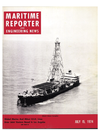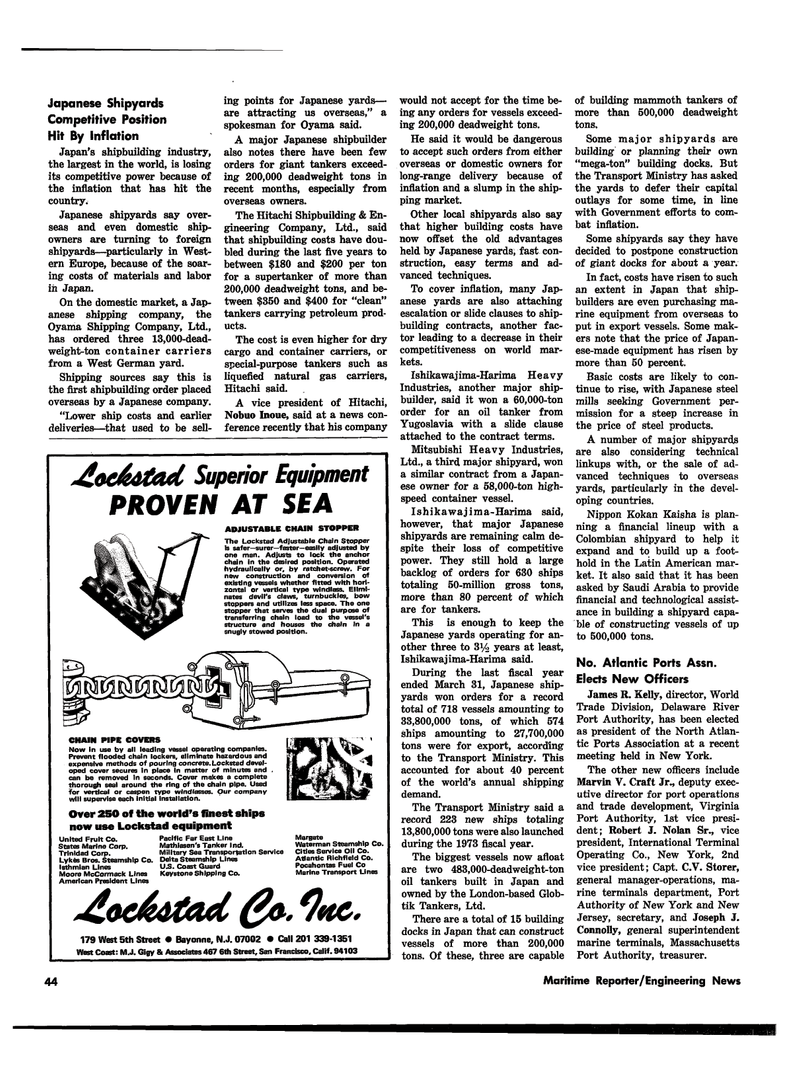
Page 46: of Maritime Reporter Magazine (July 15, 1974)
Read this page in Pdf, Flash or Html5 edition of July 15, 1974 Maritime Reporter Magazine
Japanese Shipyards
Competitive Position
Hit By Inflation
Japan's shipbuilding industry, the largest in the world, is losing its competitive power because of the inflation that has hit the country.
Japanese shipyards say over- seas and even domestic ship- owners are turning to foreign shipyards—particularly in West- ern Europe, because of the soar- ing costs of materials and labor in Japan.
On the domestic market, a Jap- anese shipping company, the
Oyama Shipping Company, Ltd., has ordered three 13,000-dead- weight-ton container carriers from a West German yard.
Shipping sources say this is the first shipbuilding order placed overseas by a Japanese company. "Lower ship costs and earlier deliveries—that used to be sell- ing points for Japanese yards— are attracting us overseas," a spokesman for Oyama said.
A major Japanese shipbuilder also notes there have been few orders for giant tankers exceed- ing 200,000 deadweight tons in recent months, especially from overseas owners.
The Hitachi Shipbuilding & En- gineering Company, Ltd., said that shipbuilding costs have dou- bled during the last five years to between $180 and $200 per ton for a supertanker of more than 200,000 deadweight tons, and be- tween $350 and $400 for "clean" tankers carrying petroleum prod- ucts.
The cost is even higher for dry cargo and container carriers, or special-purpose tankers such as liquefied natural gas carriers,
Hitachi said.
A vice president of Hitachi,
Nobuo Inoue, said at a news con- ference recently that his company would not accept for the time be- ing any orders for vessels exceed- ing 200,000 deadweight tons.
He said it would be dangerous to accept such orders from either overseas or domestic owners for long-range delivery because of inflation and a slump in the ship- ping market.
Other local shipyards also say that higher building costs have now offset the old advantages held by Japanese yards, fast con- struction, easy terms and ad- vanced techniques.
To cover inflation, many Jap- anese yards are also attaching escalation or slide clauses to ship- building contracts, another fac- tor leading to a decrease in their competitiveness on world mar- kets.
Ishikawajima-Harima Heavy
Industries, another major ship- builder, said it won a 60,000-ton order for an oil tanker from
Yugoslavia with a slide clause attached to the contract terms.
Mitsubishi Heavy Industries,
Ltd., a third major shipyard, won a similar contract from a Japan- ese owner for a 58,000-ton high- speed container vessel.
Ishikawajima-Harima said, however, that major Japanese shipyards are remaining calm de- spite their loss of competitive power. They still hold a large backlog of orders for 630 ships totaling 50-million gross tons, more than 80 percent of which are for tankers.
This is enough to keep the
Japanese yards operating for an- other three to 3y2 years at least,
Ishikawajima-Harima said.
During the last fiscal year ended March 31, Japanese ship- yards won orders for a record total of 718 vessels amounting to 33,800,000 tons, of which 574 ships amounting to 27,700,000 tons were for export, according to the Transport Ministry. This accounted for about 40 percent of the world's annual shipping demand.
The Transport Ministry said a record 223 new ships totaling 13,800,000 tons were also launched during the 1973 fiscal year.
The biggest vessels now afloat are two 483,000-deadweight-ton oil tankers built in Japan and owned by the London-based Glob- tik Tankers, Ltd.
There are a total of 15 building docks in Japan that can construct vessels of more than 200,000 tons. Of these, three are capable of building mammoth tankers of more than 500,000 deadweight tons.
Some major shipyards are building or planning their own "mega-ton" building docks. But the Transport Ministry has asked the yards to defer their capital outlays for some time, in line with Government efforts to com- bat inflation.
Some shipyards say they have decided to postpone construction of giant docks for about a year.
In fact, costs have risen to such an extent in Japan that ship- builders are even purchasing ma- rine equipment from overseas to put in export vessels. Some mak- ers note that the price of Japan- ese-made equipment has risen by more than 50 percent.
Basic costs are likely to con- tinue to rise, with Japanese steel mills seeking Government per- mission for a steep increase in the price of steel products.
A number of major shipyards are also considering technical linkups with, or the sale of ad- vanced techniques to overseas yards, particularly in the devel- oping countries.
Nippon Kokan Kaisha is plan- ning a financial lineup with a
Colombian shipyard to help it expand and to build up a foot- hold in the Latin American mar- ket. It also said that it has been asked by Saudi Arabia to provide financial and technological assist- ance in building a shipyard capa- ble of constructing vessels of up to 500,000 tons.
No. Atlantic Ports Assn.
Elects New Officers
James R. Kelly, director, World
Trade Division, Delaware River
Port Authority, has been elected as president of the North Atlan- tic Ports Association at a recent meeting held in New York.
The other new officers include
Marvin V. Craft Jr., deputy exec- utive director for port operations and trade development, Virginia
Port Authority, 1st vice presi- dent; Robert J. Nolan Sr., vice president, International Terminal
Operating Co., New York, 2nd vice president; Capt. C.V. Storer, general manager-operations, ma- rine terminals department, Port
Authority of New York and New
Jersey, secretary, and Joseph J.
Connolly, general superintendent marine terminals, Massachusetts
Port Authority, treasurer.
Jtocfatad Superior Equipment
PROVEN AT SEA
ADJUSTABLE CHAIN STOPPER
The Lockstad Adjustable Chain Stopper is safer—surer—faster—easily adjusted by one man. Adjusts to lock the anchor chain in the desired position. Operated hydraulfcally or, by ratchet-screw. For new construction and conversion of existing vessels whether fitted with hori- zontal or vertical type windlass. Elimi- nates devil's claws, turnbuckles, bow stoppers and utilizes less space. The one stopper that serves the dual purpose of transferring chain load to the vessel's structure and houses the chain in a snugly stowed position.
CHAIN PIPE COVERS
Now in use by all leading vessel operating companies.
Prevent flooded chain lockers, eliminate hazardous and expensive methods of pouring concrete. Lockstad devel- oped cover secures in place in matter of minutes and can be removed in seconds. Cover makes a complete thorough seal around the ring of the chain pipe. Used for vertical or caspen type windlasses. Our company will supervise each initial installation.
Over 2S0 of the world's finest ships now use Lockstad equipment
United Fruit Co.
States Marine Corp.
Trinidad Corp.
Lyk&s Bros. Steamship Co.
Isthmian Lines
Moore McCormack Lines
American President Lines
Pacific Far East Line
Mathiasen's Tanker Ind.
Military Sea Transportation Service
Delta Steamship Lines
U.S. Coast Guard
Keystone Shipping Co.
Margate
Waterman Steamship Co.
Cities Service Oil Co.
Atlantic Richfield Co.
Pocahontas Fuel Co
Marine Transport Lines ^oc&^tad ^ttc. 179 West 5th Street • Bayonne, N.J. 07002 O Call 201 339-1351
West Coast: M.J. Gigy & Associates 467 6th Street, San Francisco. Calif. 94103 44 Maritime Reporter/Engineering News

 45
45

 47
47
